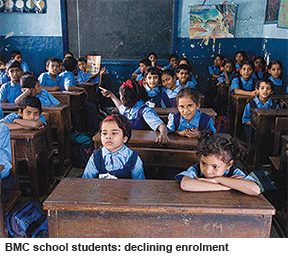 The brihanmumbai municipal Corporation (BMC) aka Municipal Corporation of Greater Mumbai (MCGM), the richest civic government in India, presented its budget for 2015-16 on February 5. In the Rs.33,514.15 crore budget, education has been allocated a substantial Rs.2,500.89 crore (7.46 percent) to inter alia promote ten new schools, establish 200 computer labs in the corporation’s 1,153 schools with an aggregate enrolment of 404,251 students, and provide all class VIII upward students electronic tablets. “The idea behind tablets is to reduce the weight of school bags carried by students,” says Vinod Shelar, chair of MCGM’s education committee.
The brihanmumbai municipal Corporation (BMC) aka Municipal Corporation of Greater Mumbai (MCGM), the richest civic government in India, presented its budget for 2015-16 on February 5. In the Rs.33,514.15 crore budget, education has been allocated a substantial Rs.2,500.89 crore (7.46 percent) to inter alia promote ten new schools, establish 200 computer labs in the corporation’s 1,153 schools with an aggregate enrolment of 404,251 students, and provide all class VIII upward students electronic tablets. “The idea behind tablets is to reduce the weight of school bags carried by students,” says Vinod Shelar, chair of MCGM’s education committee.
Unfortunately, even as the education budget of BMC has risen steadily from Rs.1,255 crore in 2009 to Rs.2,500 crore in the current year, BMC customers, i.e parents and students are unimpressed. According to an estimate made by the Praja Foundation (estb.1997), a Mumbai-based NGO promoted to “re-establish accountability and transparency in governance”, 51,649 children have dropped out of BMC schools during the past five years. “What’s the point of constructing new schools when BMC’s existing schools are emptying out because of functional disorders. It takes more than gizmos like tablets and iPads to improve BMC schools,” says Milind Mhaske, a business management graduate of Bombay University and former entrepreneur who was appointed director of Praja Foundation in 2010.
According to a white paper published by the foundation, not only are children steadily dropping out of BMC schools, the number of children signing up is also declining. Enrolments in class I dropped from 67,477 in 2009-10 to 39,663 in 2013-14, with data from a 2014 survey of 22,850 households indicating that 63 percent of households are dissatisfied with the quality of education delivered, of whom 44 percent are unhappy with teachers of BMC schools.
“The major lacuna of BMC schools is lack of accountability for education quality at all levels. To improve learning outcomes and retention rates, School Management Committees (SMCs) comprising a majority of parents as prescribed by the RTE Act, 2009, need to be established to draw up school development plans (SDPs) for every school. Unfortunately, even if SMCs are constituted, SDPs haven’t been drawn up. Unless SMCs become active and involved, government schools will remain unaccountable and suffer decline,” says Mhaske.
The reluctance of politicians in the BMC — ruled by a BJP-Shiv Sena coalition — to teach English seriously even as a second language, is another cause of the diminishing popularity of BMC schools. “In all of India’s 29 states and Union territories ill-advisedly divided on linguistic considerations way back in 1956, politicians and bureaucrats are neck-deep in textbook printing and teacher appointment rackets. If English is taught seriously, many textbook contracts will be lost as well teaching jobs for rural kith and kin schooled in vernacular languages,” says a Mumbai-based academic speaking on condition of anonymity.
Clearly, unless these nuts and bolts issues affecting the quality of education dispensed in BMC schools are addressed and repaired, the exodus of students will continue, if not accelerate. Throwing money at problems won’t make them disappear.
Shweta Nair (Mumbai)


























